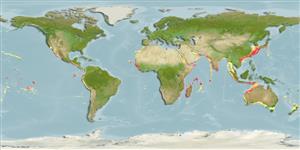Environment: milieu / climate zone / depth range / distribution range
Écologie
marin récifal; profondeur 50 - 300 m (Ref. 28016). Subtropical; 35°N - 50°S, 32°E - 5°W
Southeast Atlantic: St. Helena and Ascension islands (Ref. 7097). Western Indian Ocean: southern Red Sea, off Oman and Sri Lanka. Eastern Pacific: Hawaiian and Revillagigedo islands (Ref. 9283). Reported from the Arafura Sea (Ref. 9819) and Persian Gulf (Ref. 68964).
Taille / Poids / Âge
Maturity: Lm ? range ? - ? cm
Max length : 58.0 cm TL mâle / non sexé; (Ref. 55763); common length : 35.0 cm TL mâle / non sexé; (Ref. 55763)
Épines dorsales (Total) : 9; Rayons mous dorsaux (Total) : 25 - 30; Épines anales: 3; Rayons mous anaux: 19 - 22.
Adults are benthopelagic in sandy bottoms at the foot of the edge of the outer reefs, continental coasts and around islands (Ref. 9283). Solitary or forming small schools (Ref. 30573). Mainly nocturnal (Ref. 4887). Marketed fresh and salted or dried (Ref. 9283).
Life cycle and mating behavior
Maturité | Reproduction | Frai | Œufs | Fécondité | Larves
Smith-Vaniz, W.F., 1984. Carangidae. In W. Fischer and G. Bianchi (eds.) FAO species identification sheets for fishery purposes. Western Indian Ocean fishing area 51. Vol. 1. [pag. var.]. FAO, Rome. (Ref. 3287)
Statut dans la liste rouge de l'IUCN (Ref. 130435: Version 2024-2)
Menace pour l'homme
Harmless
Utilisations par l'homme
Pêcheries: intérêt commercial mineur; pêche sportive: oui
Outils
Articles particuliers
Télécharger en XML
Sources Internet
Estimates based on models
Preferred temperature (Ref.
123201): 14.5 - 26.8, mean 20.2 °C (based on 410 cells).
Phylogenetic diversity index (Ref.
82804): PD
50 = 0.6250 [Uniqueness, from 0.5 = low to 2.0 = high].
Bayesian length-weight: a=0.01413 (0.00826 - 0.02417), b=2.95 (2.81 - 3.09), in cm total length, based on LWR estimates for this species & (Sub)family-body (Ref.
93245).
Niveau trophique (Ref.
69278): 3.8 ±0.58 se; based on food items.
Résilience (Ref.
120179): Milieu, temps minimum de doublement de population : 1,4 à 4,4 années (Preliminary K or Fecundity.).
Fishing Vulnerability (Ref.
59153): Moderate vulnerability (43 of 100).
Nutrients (Ref.
124155): Calcium = 30.3 [14.2, 54.0] mg/100g; Iron = 0.813 [0.459, 1.464] mg/100g; Protein = 20.2 [19.2, 21.2] %; Omega3 = 0.257 [0.163, 0.421] g/100g; Selenium = 23.1 [12.1, 42.8] μg/100g; VitaminA = 48.7 [18.3, 128.0] μg/100g; Zinc = 0.579 [0.394, 0.848] mg/100g (wet weight);
